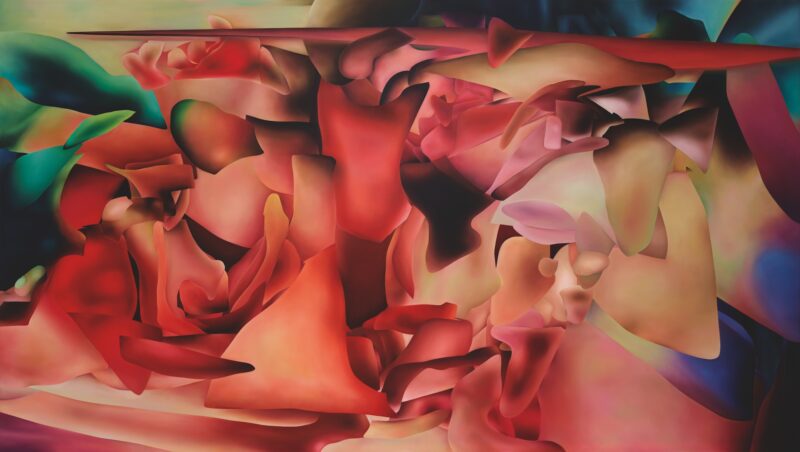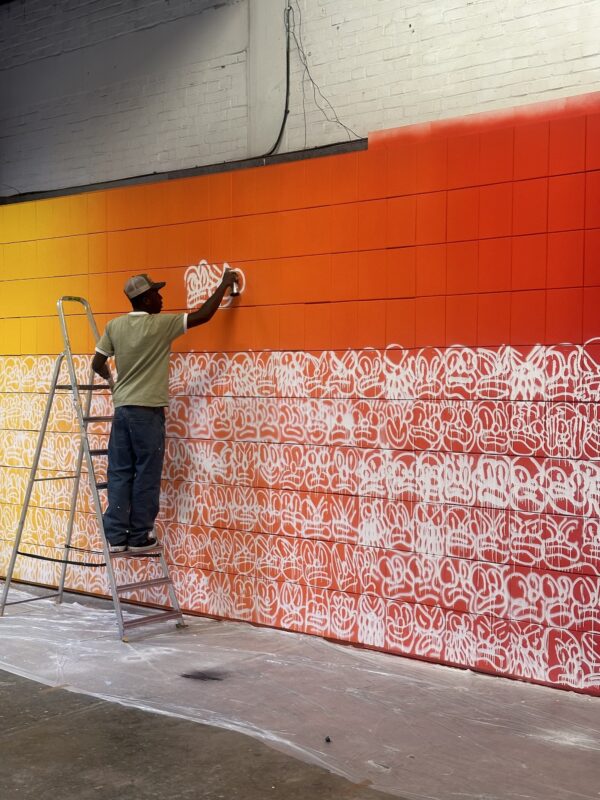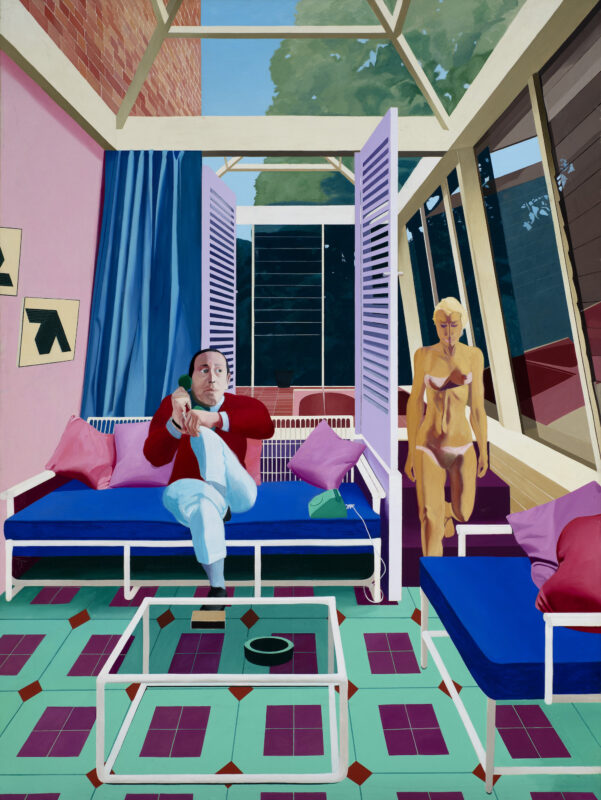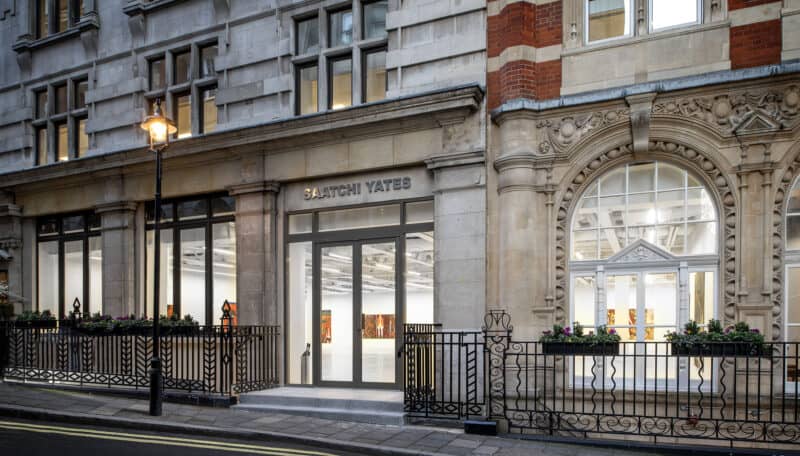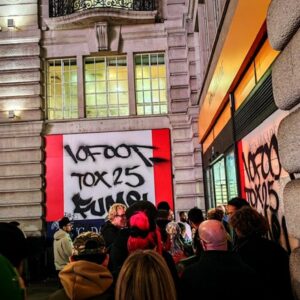Nokukhanya Langa’s debut exhibition delves into the world of modern media and internet culture while breaking the rules of traditional painting. Langa’s never-ending Hypnotic multi-coloured spirals and infinite gradients portray her interest in the loss of the image, and by extension, of reality.
Born in Silver Spring, Maryland, USA, and now based in Ghent, Belgium, Langa has grown up living between the United States, India, South Africa, The Netherlands, and Belgium. Her art practice reconciles the pluralities of her personal story, mixed cultural heritage, and lived experiences; all coming together to form part of her large-scale paintings, filled with vibrant imagery in a stream-of-consciousness style.
We managed to grab some time with Noku at Saatchi Yates prior to the opening.
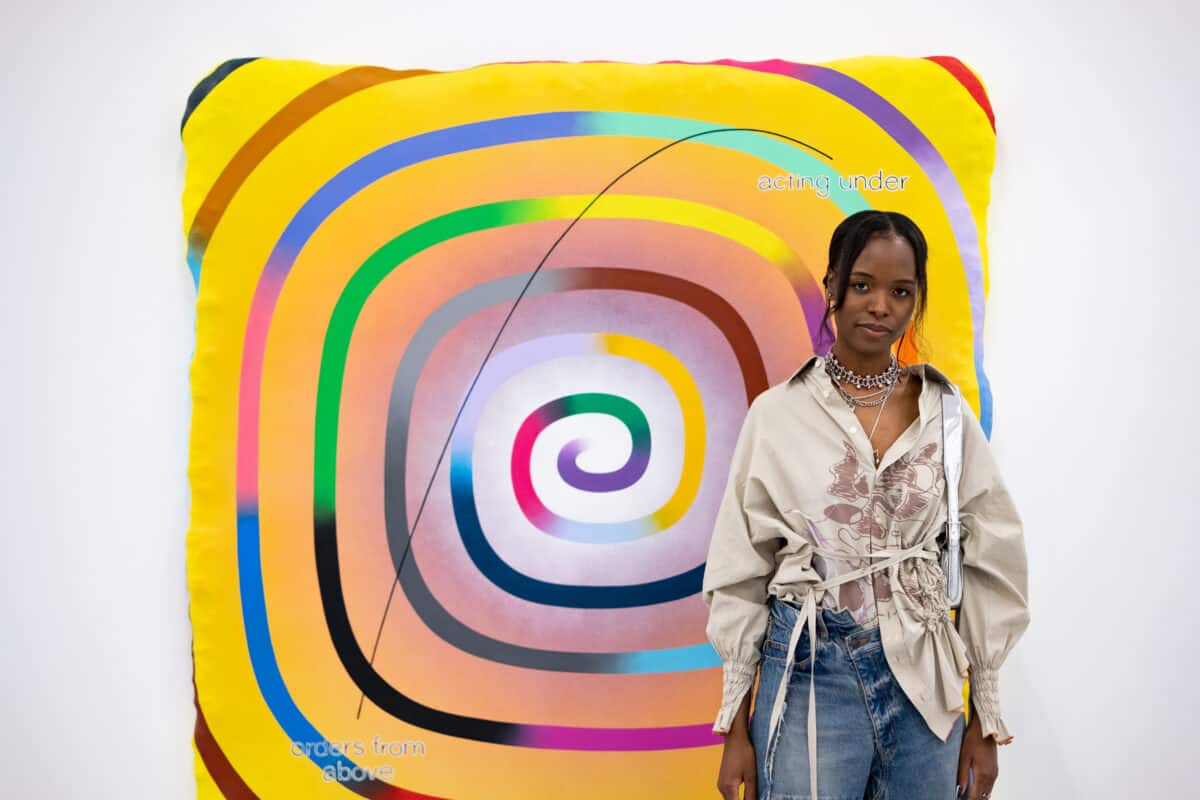
Mark Westall: So you started off with these ones, the spirals?
Nokukhanya Langa: Yes, I think I started working with this motif– I was doing a group show, it was about history, and I was already kind of on this idea of thinking about personal history, like, how do you make it less personal? Because sometimes it’s not as interesting and I kinda thought from a visual point of view also i’m quite interested in how things look sometimes. I used it like a motif to keep working on this painting, and I think it was kind of perfect, because the way I work, I wanna be like really playful, one, but also incorporate symbols that point in other end points other directions. I think a spiral is just kind of– In the Western culture is a thing that really refers to mental states and all kinds– Like someone going crazy, or something that’s deteriorating. I like this idea that something that’s quite playful and colorful can also reference something thats quite serious.
MW: Yes and the colors are great. I mean, is the color choice just– You just do it?
NL: Yes, it’s really intuitive, and it’s also something that’s–
MW: Intuitive that’s the word!
NL: Yes, I like that, because I think I used to think constantly before I started painting and planned everything out. I got really sick of working like this. I felt like I’m actually– I didn’t feel like an artist because I was constantly like, “I’m going to do that–” I had to plan everything out, looking at other paintings to make sure– Sometimes you’re given this opportunity as an artist to be very imaginative and as playful as anything as you want, why not take that?
MW: You just let it flow, let it come out.
NL: Yes, you have to trust yourself. You have all this muscle memory of going to school and painting and working with color, and when you work in intuitive ways, that doesn’t disappear, but its not as rigid, it’s like, “I have to put this color into this color.” It’s not as planned, so this playfulness is very important. I like that also, the paintings have this underlying uneasiness, because I think that’s something I’m actually interested in. It’s kind of– Something is wrong. Like, this constant idea that something is wrong.
MW: I think a lot of people are feeling anxious at the moment.
NL: Yes, for sure. I think especially the last two years, it’s like, “All right, we can’t hide anymore.”
MW: Do you live in America now?
NL: No, I haven’t lived there for probably about nine years. I’m based in Belgium. I’ve lived in Belgium since 2020; since I did a residency at the Higher Institute for Fine Arts (HISK) in Ghent where I now live, things kind of worked, just kept going from there. So I have a studio there still, but I’ll be based in Rotterdam in the future.
MW Rotterdam is amazing
NL: Yes- It’s like scale, everything is different. So I really like it. It’s the only place in the Netherlands I’m like, okay yes, I could live here. I think Belgium was a cool place for me because I think things aren’t– Netherlands can be a bit rigid and– Brussels, and I think in Belgium in general, has like a interesting, I think living in Belgium let me– gave me this encouragement to be more playful in the way I work because the Netherlands are a lot more serious. Like Belgium and the Netherlands are close, they have a shared history and overlapping things, but I feel the vibe in the Netherlands was kind of stifling for me. It’s like you can also go on there where you ride your bike on the sidewalk for like two seconds someone is yelling at you, telling you to like do the right thing, so–
MW: This is where this work was made in Belgium?
NL: Yes, Belgium. It’s all recent work.
MW: Now you get to make bigger work now that you’ve moved to Rotterdam? You’ve got more space?
NL: I actually don’t have a studio yet, so I don’t know. I like this idea of scale, like these little spirals and it’s like these really big ones so I would love to push that bit and keep going and see where–
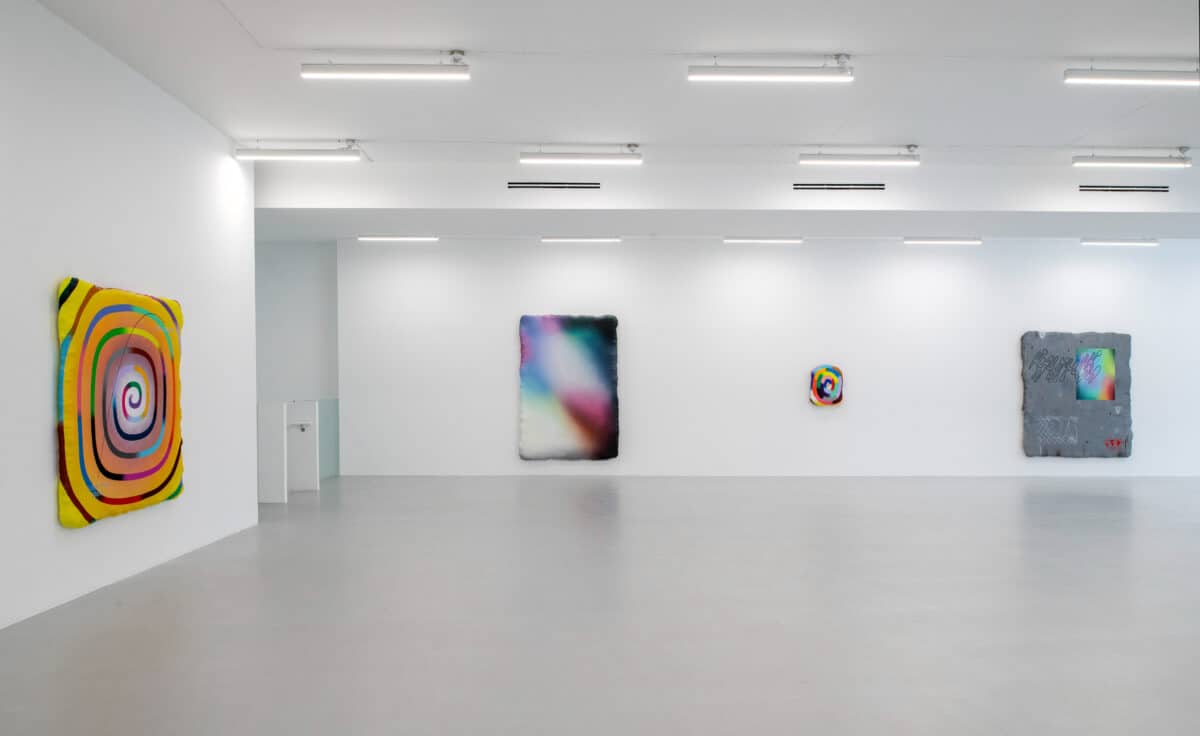
MW: They look like– I love the way that they look like cushions not like traditional artworks with big heavy frames they could float off or something. It’s part of the playfulness I suppose.
NL: Yes, for sure. It’s all from I guess a bit of a play comes to mind like–or an illusion in a way. Because painting for me– I used to think in a very realistic, traditional style. So illusion was always– you know this idea of paint naturally, like you can make something look exactly like– As I kind of naturally gravitated away from that, I still like this idea of play and illusion and trickery–
MW: Yes, you just see that little blue one upstairs. You get people to come because it looks un-scary, but actually, the subject matter is pretty heavy.
NL: Yes, you don’t want it to be all dark and scary and menacing and they keep their distance, you want to draw people in and then–
MW: You found a diagram for that one before you–
NL: I was really just looking and to collect diagrams. Sometimes I just look things up and like diagram of so, so, and so. You can type anything in, and sometimes I find the diagrams naturally just being online. So I started collecting diagrams and so I have just a little diagram. That’s on one of the gray paintings and I was like, I want to use another diagram and then that painting comes out of it. I feel like when you make something like a painting like that, that looks like it doesn’t really fit. Then the future I can also go down that avenue. That can be its own series. I like that it can spread out like tendrils.
MW: How do you keep this stuff, the images and the words and the diagram sort of thing?
NL: On my laptop, my really old shitty laptop. It’s going to die. I’m so terrified that it’s basically just a hard drive and it’s really old, but I keep it on my laptop and I keep it on my phone. They’re always in different places in Sketchbooks. It’s either it’s drawings or like writings. I’ll go through my schedule and like, “Oh yes, this is something I wrote.” Then I’ll put in a Google Drive.
MW: You said you were talking about you just collect images and text.
NL: Yes, I think it’s also like kind of identity information, sometimes you form an identity around the things that we collect, and for me I collect things that I see or images, they’re really important, have always been important to me, it’s kind of my only upbringing language that I– It’s like phrases and things, and I think all my life when I was a kid, when we were growing up like shifting through around cultures, you have to be an observer, so– I was a starer. I would just stare all the time–
MW: You’re trying to work out how you fit in?
NL: Yes, I do, either staring at people for an incomparably long time, or you’re listening to things people say, and you’re like, oh that’s why I say that, that’s how I assimilate, that’s how I fit this identity into where I am. So I think this is something that stays with me and instead I use it like a toolbox to make work.
MW: It’s not just you, though. Everyone my age has been talking about kids dressing like it’s the 90s. And the fact it’s perfect, they don’t even give it a twist.
NL: No, no. It’s like one-on-one, one-to-one, yes.
MW: They’ve been doing like that kind of research.Everyone does research now.
NL: Yes. It’s crazy actually, I’ll be like, what the hell? It’s incredible, I think it’s a bit like we’ve become a sample culture.. I know the sample, that’s from this song from the seventies or eighties or whatever and I kind of just– yes, it’s also information when you sample things and you pick and choose and put them together and create something else or something that’s the same or– it’s like I like this idea of sound as well. I think it also goes back to the idea of ownership and property and who owns what and what you’re allowed to use. I think that’s–
MW: I hate all that stuff. I hate it. I get it some people make a lot of money and if you are a scientist and you invent something, I get it, but-
NL: This is like a completely conversation that can go– It’s a philosophical thing. If you’re in this kind of world, of course, we’re influenced by one another and probably even more so now we have so much more access. It’s like– I used to talk with my mum. When I told her like, “Hey, I think I’m going to study art, but at liberal arts school and she freaked out. She’s like, “How are you going to make something new like everything–?” I was like, “I’m not. I don’t really want to make anything new.” I think at that point I recognized that we’re all like a succession of some ideas that someone’s already done.
MW: It can be fresh. Like work is not the same as people painting stuff with oil. Even if they do abstract stuff for me. I know it’s the fact that your stuff is painted, but it’s not. It’s not– I went to Bogotá. It’s a few years ago to a thing called Art Bogotá.
NL: The art is beautiful. My friend comes from there, I really like to look at art from South America because they also have their own thing. Especially if they’re coming out of the schools and academies there. You realize how much the culture influences the art there and looking at that and not really having a parallel like our contemporary parallels. We really see how these worlds are forming and what’s important and what’s relevant to issues and cultures. I find that really fascinating and sometimes like I lived in India. I was talking to the galleries. It’s like, I really hate it when people from India, people who are Indian go and they study elsewhere and they come back and they make this horrible abstract shit. It’s like, actually, no, you want the work that you were making here. Definitely, there is this thing when you like leave and come back and they can change. I think sometimes people just want– I think, especially what was fascinating about India and that’s when I decided I’m going to leave. I won’t do a master’s in India. I’m just going to go to the Netherlands. Is that, they’re really interested in their culture and their history, the buyers there. It’s a bit insular, but you see how they’re really trying to–
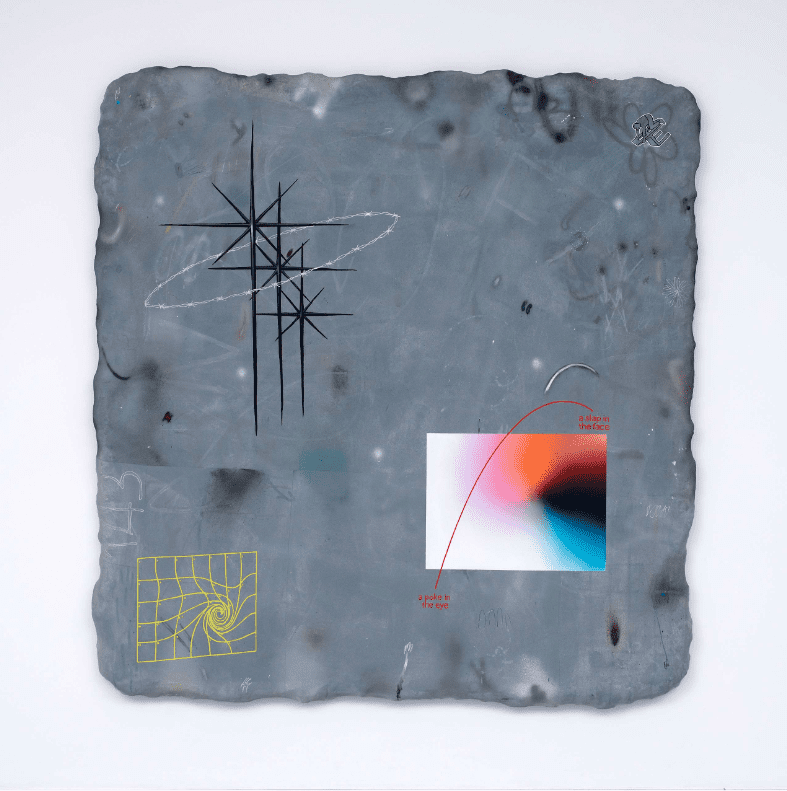

MW: I just remembered right at the beginning when we were upstairs in the exhibition you talked about how some of your works (the concrete ones) are about places.
NL: The grey ones are about places. It’s about recreating this place in a very literal way and concrete. These ones are about places and memories. They also have this collection of images that I have. I’m retroactively going and using the image I found in my adult life and applying to the memories. That way, obviously memory is like a false narrative already but it becomes symbolic. These ones are named after Rose. Sometimes they have numbers in them so you can actually look up the number and the name of the title and you could find the place
MW: It’s weird when you go back to places and they’re totally different.
NL: It’s like I can’t remember– That’s an amazing thing about memory. It’s so fluid.
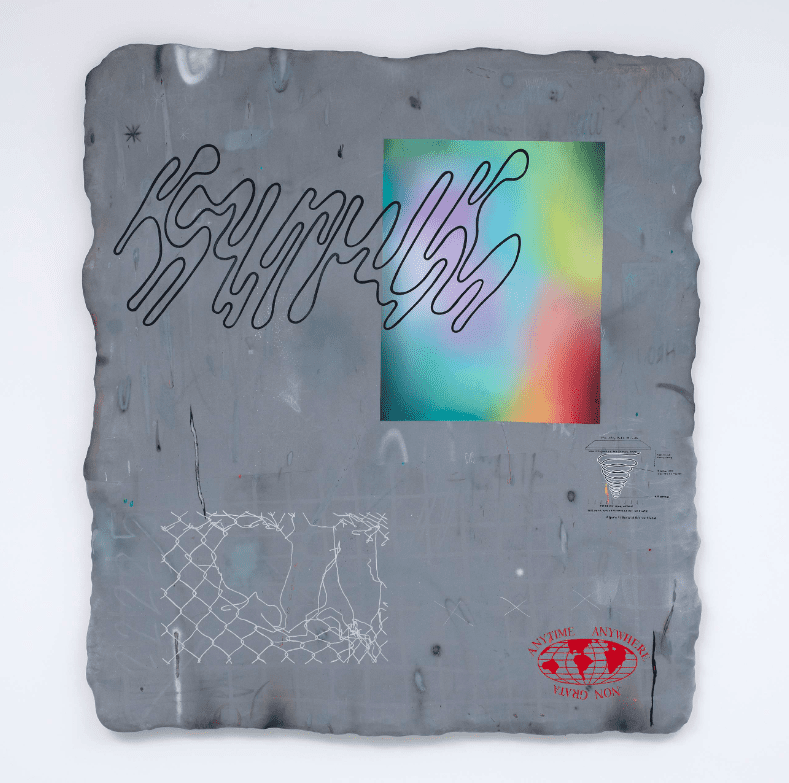
MW: This show, how did it come about? How did you meet the guys?
NL: They reached out to me sometime last year when I was still in the HISK. They were like,
“We really like your work.”
MW: How did they see your work?
NL: I think they saw my work– I was doing a little solo show in New York through NADA. They have a booth in Chinatown, in New York City. I was doing this little show with a gallery in Brussels called Ballon Rouge. They set me up with the show. I think that’s where they saw my work, and they started researching me. They were like, “Look, we really want to do something with you. Let’s do a show.” They brought me out to the gallery, and I was like, “This is huge.” This place is huge. There’s so much floor, but I think it was just really cool. I think, for me, the space was really intimidating when they approached me, but they’re so enthusiastic and encouraging. They’re young, and they were really enthusiastic about my work. They were the ones who really got me on– It’s been really great working with them. They’re also my biggest cheerleaders, which sometimes you need that because there’s a lot of doubt and isolation in your studio. It’s been really fun working with them.
MW: Oh, it’s super fun work. It’s like– What about this one?
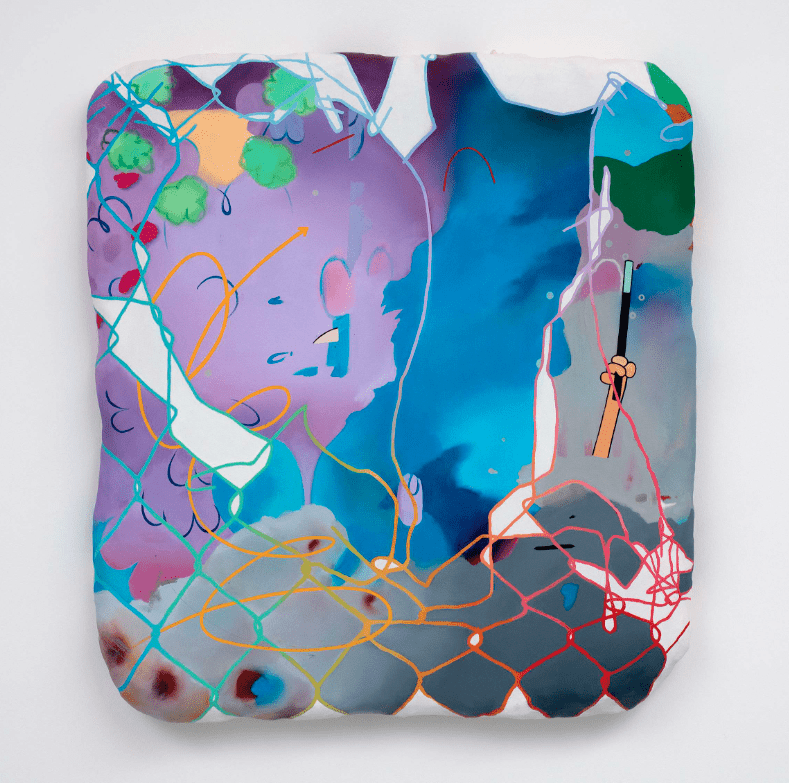
NL: This one’s called A Rattling in the Brain. I did it for a show. I did it in Melly, Kunstinstituut Melly in Rotterdam. This show was called A Downward Spiral Is A Loaded Spring. The plan was a motif that I have of my work. I really wanted the show to be about just being in just a head space. So you go in this room, it has this glass and a huge glass front, and it’s small. I wanted it to be like you’re just entering someone’s head, and there’s text all over the floor, and none of it makes sense. This painting was part of this theme of downward spiral is a loaded spring.
MW: It’s chaos, but it’s also got a bit of landscaping.
NL: A little skyscape.
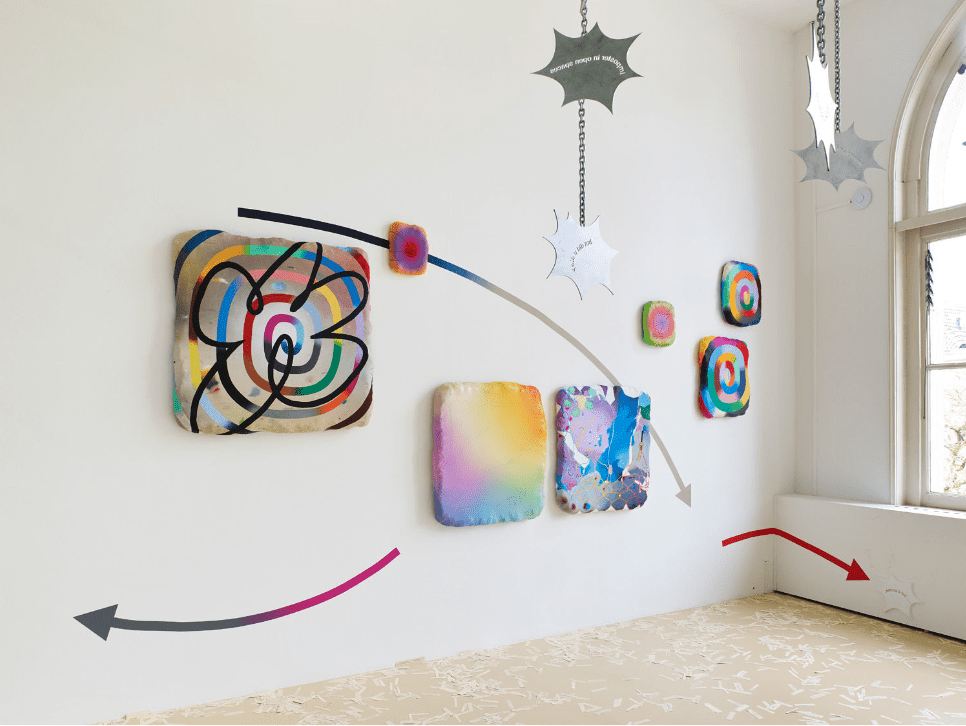
MW: Yes, and leaves. I wonder why these works are in here. Did you help with the curation?
NL: No, For me, I like working in different ways. Normally, I’m really specific about the space. I’m going to make some kind of invention where there’s a mural, or there’s some sculptures in there. I want to make a little experience. I think for the first time I wanted to do just a painting show because I always lean on this–
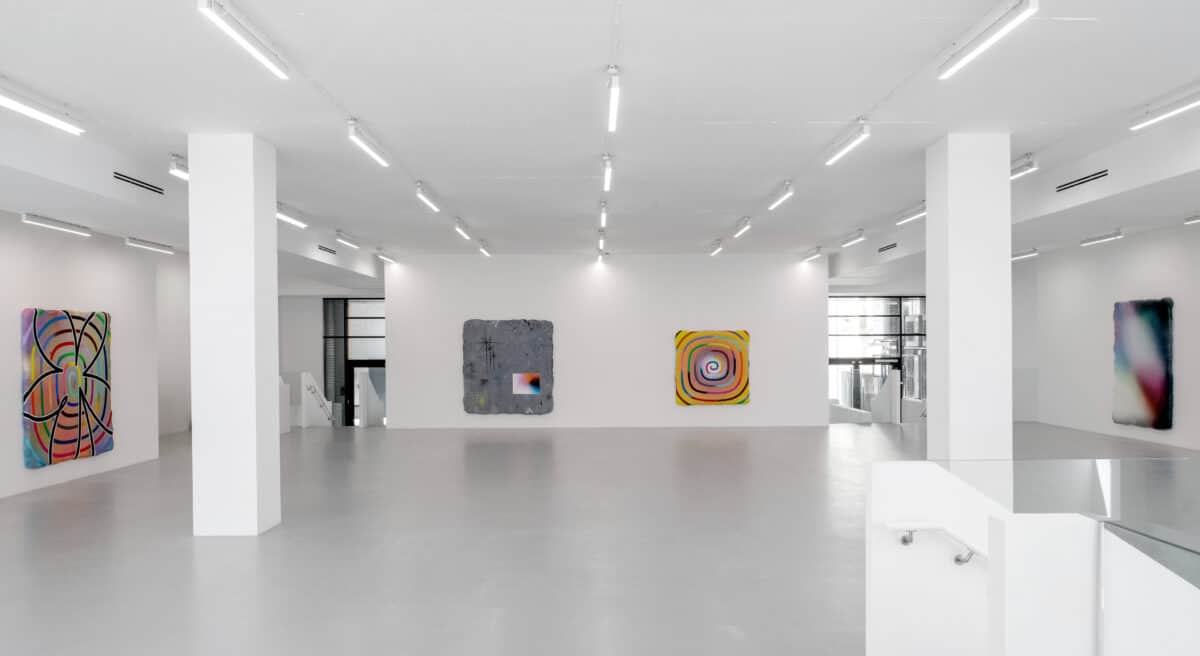
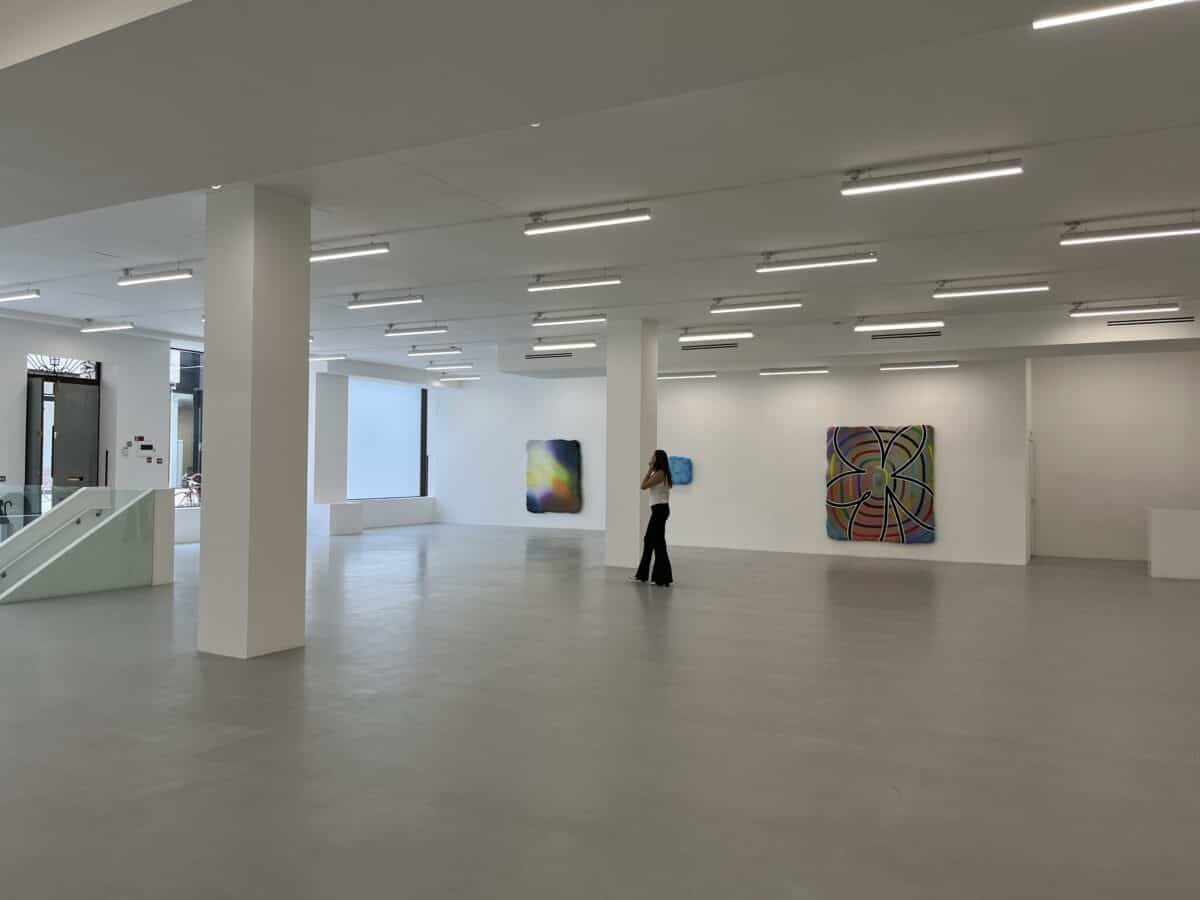
MW: It’s a big space, but the show is cool
NL: Yes. It’s cool to see them just on their own. Normally, I’m always doing something. I was like, step back a bit. I was like, here are the paintings, and I don’t have too much control over how it all’s going to set up, but I want it to be a painting show because I had moments when there was stuff I didn’t like. Let me do Let me do this. I did know that I wanted to have a room full of the spirals that are downstairs. I knew that I was meant to deliver work that exists in the same family. The work in here, I feel like they all add on to each other.
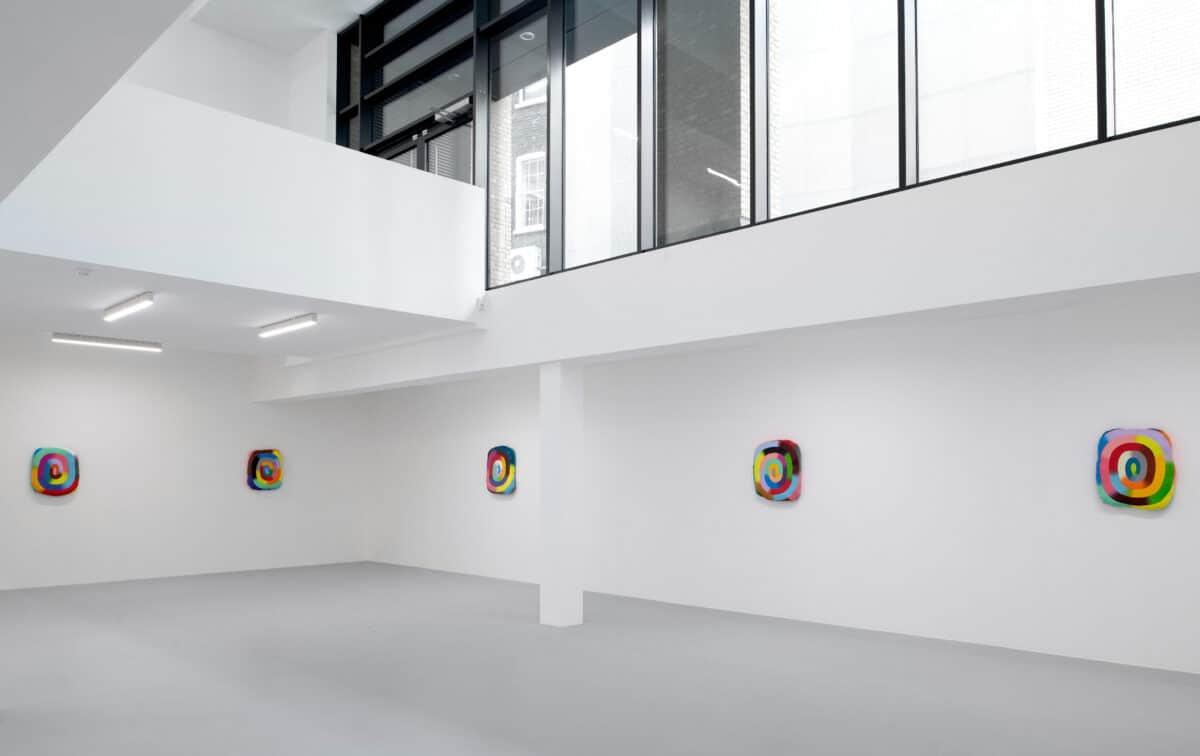
MW: It looks nice upstairs. It kind of looked raw. You know what I mean? It’s like because it’s cartooney and I expect to see Donald Duck coming up this stairway, maybe not that literal, but it’s–
NL: It’s almost like it leans over this kitsch, cheesy. I love this because I would’ve never off let myself do anything too playful, too cheesy. I would never have leaned into this because I always want to be a serious painter or that’s why I thought it–
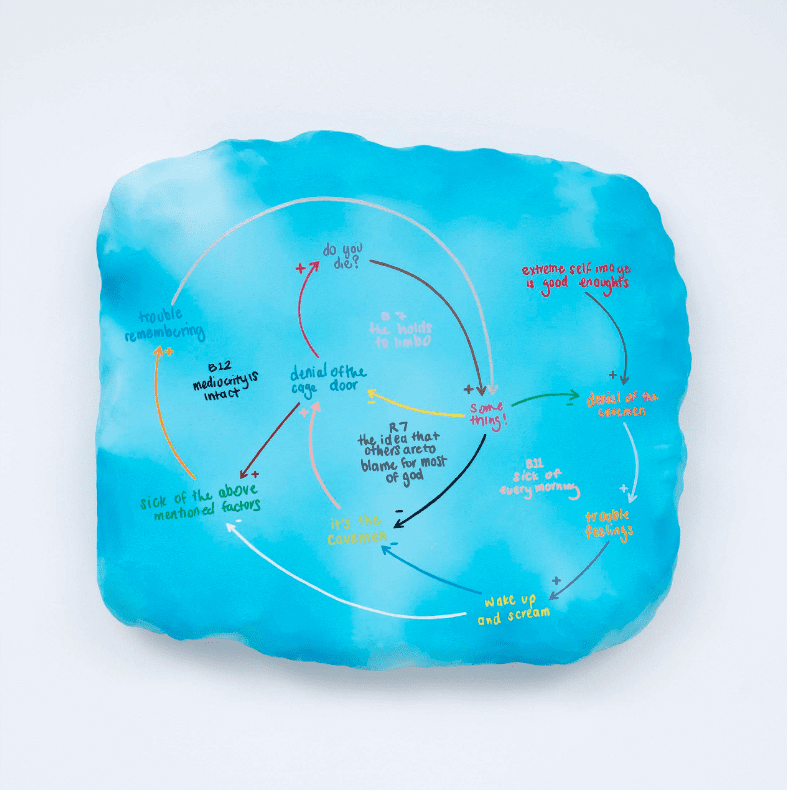
MW: Well, I think it’s great, especially– the most obvious serious one, the little blue one with the words and the diagram about depression. You don’t get it until you look at it properly. You would never know, but some of the others have taken a bit more. You say it’s not really about you, but it is, or it’s not obvious it’s about you, but it kind of is. Like the Jesus crown and all that. It’s nice. It’s nice to have something you can look at, and you find stuff over time rather than all at once.
NL: I think also sometimes a lot of things are personal, but I also want to leave them so open that it can mean nothing.
MW: Does making the work, is it therapy to you? Does it cheer you up?
NL: Well, yes. I think I’ve always been really obsessive. I think this is why I ended up being an artist because I used to draw obsessively. I wanted to be really good at drawing as a kid, so I just never stopped drawing. For me, when I draw and/or paint, it is just because it’s something I really love to do. Sometimes I’m like, [sighs] “I’ve got to make it work,” and then I start painting, and I was like, “This is so nice.” I really enjoy this.
MW: How was it getting stuff ready for this? Was there a deadline?
NL: Yes, there was a deadline. It was crazy. I was like, I really want to push myself. I want to make 18 paintings. I want to have this X amount of paintings. For me, I have this goal for myself and I really wanted to meet it, so I wanted to work in a way that was really……..
You can see Nokukhanya Langa on view until 6th November 2022 at Saatchi Yates
About the artist
Born in Silver Spring, Maryland, USA, and now based in Ghent, Belgium, Langa has grown up living between the United States, India, South Africa, The Netherlands, and Belgium. Her art practice reconciles the pluralities of her personal story, mixed cultural heritage, and lived experiences; all coming together to form part of her large-scale paintings, filled with vibrant imagery in a stream-of-consciousness style.
Unlearning the rigidity of her training in traditional oil painting, she plays with abstract motifs; colour, swirls, and other fluid shapes, working in unison with more recognisable motifs like text and signs. Shifting back and forth between figuration and abstraction, the result is an agile use of approachable jargon and aesthetics that convey the more subtle, and incendiary subtext of the works in a kind of hallucinatory reality. This body of works builds on the selection presented at the Melly Museum in Rotterdam earlier in 2022. @nokukhanyalanga
